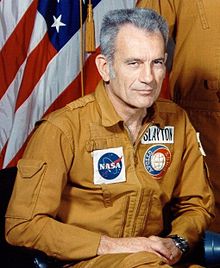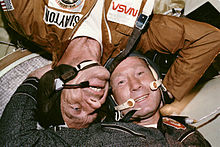- Deke Slayton
-
Donald Kent "Deke" Slayton 
NASA Astronaut Nationality American Born March 1, 1924
Sparta, WisconsinDied June 13, 1993 (aged 69)
League City, TexasOther occupation Bomber pilot; Test pilot Rank Major, USAF Time in space 9d 01h 28m Selection 1959 NASA Group Missions Apollo-Soyuz Test Project Mission insignia 
Donald Kent Slayton (March 1, 1924 – June 13, 1993), better known as Deke Slayton, was an American World War II pilot and later, one of the original NASA Mercury Seven astronauts.[1]
After joining NASA, Slayton was selected to pilot the second U.S. manned orbital spaceflight, but was grounded in 1959 by a heart murmur. He then served as NASA's Director of Flight Crew Operations, making him responsible for crew assignments at NASA from November 1963 until March 1972. At that time he was granted medical clearance to fly, and was assigned as the docking module pilot of the 1975 Apollo-Soyuz Test Project; becoming the oldest person to fly into space at age 51. This record was surpassed in 1998 by his fellow Project Mercury classmate John Glenn at the age of 77, on space shuttle mission STS-95.
Contents
Biography
Early life
Slayton was born on a farm near Sparta, Wisconsin. A childhood farm equipment accident left him with a severed left ring finger. He entered the United States Army Air Forces as a cadet in 1942, training as a B-25 bomber pilot. He flew 56 combat missions with the 340th Bombardment Group over Europe during World War II and later flew seven combat missions over Japan in a Douglas A-26 Invader as part of the 319th Bombardment Group.
After the war, Slayton earned a bachelor of science degree in aeronautical engineering from the University of Minnesota.
Slayton became a test pilot at Edwards AFB in California. He tested supersonic Air Force fighters, including the F-101, F-102, F-105, and F-106,[2] and was responsible for determining stall-spin characteristics for the large F-105, which became the principal fighter bomber used by the USAF over North Vietnam.[3]
Mercury Seven
Slayton was chosen as one of the original seven American Astronauts in 1959. He was scheduled to fly in 1962 on the second orbital flight (to have been named "Delta 7", the name coming from the mission being the fourth spaceflight—the fourth letter in the Greek alphabet and the seven astronauts), but because of an erratic heart rate (idiopathic atrial fibrillation), he was grounded, and his place was taken by Scott Carpenter aboard Aurora 7. Slayton was the only member of the Mercury Seven who did not fly in the Mercury program. He was one of the eight Paresev pilots.[4]
Gemini and Apollo selection
When NASA grounded Slayton, the Air Force followed suit. Slayton resigned his Air Force commission in 1963 and worked for NASA in a civilian capacity as head of astronaut selection. Unofficially called "Chief Astronaut," he had the decisive role in choosing the crews for the Gemini and Apollo programs, including the decision of who would be the first person on the moon.
In 1972, Slayton was awarded the Society of Experimental Test Pilots James H. Doolittle Award.
Apollo-Soyuz flight
A long medical program led to Slayton being restored to full flight status in 1972, when he was selected as docking module pilot for the Apollo-Soyuz Test Project, designed to allow a docking between the American Apollo spacecraft and the Soyuz spacecraft of the Soviet Union. On July 17, 1975, the two craft joined up in orbit, and astronauts Slayton, Thomas Stafford and Vance D. Brand conducted crew transfers with cosmonauts Aleksey A. Leonov and Valeriy Kubasov. At the end of the flight, an erroneous switch setting led to the introduction of noxious fumes into the Apollo cabin during landing, and the crew was hospitalized as a precaution in Honolulu, Hawaii for two weeks. During hospitalization, a lesion was discovered on Slayton's lung and removed. It was determined to be benign.
Upon his return from the Apollo-Soyuz Test Project flight, he became Head of Shuttle Approach and Landing Tests Program for NASA's space shuttle program.
Retirement
Slayton retired from NASA in 1982. After retirement, he served as president of Space Services Inc., a Houston-based company earlier founded to develop rockets for small commercial payloads. He served as mission director for a rocket called the "Conestoga", which was successfully launched on September 9, 1982, and was the world's first privately funded rocket to reach space.[5] Slayton also became interested in aviation racing.
Slayton penned an autobiography with space historian Michael Cassutt entitled Deke!: U.S. Manned Space from Mercury to the Shuttle. As well as Slayton's own astronaut experiences, the book describes the way in which Slayton made crew choice selections, including choosing the first person to walk on the moon. Numerous astronauts have noted that only when reading this book did they learn why they had been selected for certain flights decades earlier.
Slayton's name also appears with three other co-authors, including fellow astronaut Alan Shepard, on the book Moon Shot: The Inside Story of America's Race to the Moon, published in 1994. The book was also made into a documentary film of the same name. Slayton died before either Moon Shot project was finished or released, and the book did not receive any input from him. However, the film was narrated from Slayton's point of view (voiced by Barry Corbin) and includes a brief tribute to him at the very end.
Shortly after he moved to League City, Texas in 1992, Slayton was diagnosed with a malignant brain tumor. He died from the illness on June 13, 1993.
Legacy
With the other Mercury astronauts, Slayton was awarded the Collier Trophy in 1962 for "pioneering manned spaceflight in the USA".[6]
Slayton was enshrined in the National Aviation Hall of Fame in 1996.[7]
The Texas Oncology-Clear Lake Deke Slayton Cancer Center (located on Medical Center Blvd. in Webster, Texas) was named in his honor in 2000.[8]
The main stretch of road in League City, Texas, F.M. 518 was renamed Deke Slayton Highway.[9]
The Deke Slayton Memorial Space & Bicycle Museum in Sparta, Wisconsin was named in his honor.[10] The Museum's Donald Kent "Deke" Slayton exhibit examines the accomplishments of one of Monroe County, Wisconsin's most famous sons. Deke was born in a hospital in Sparta WI, raised on a farm just north of Leon WI. He attended elementary school in Leon WI and graduated from Sparta WI High School. The biographical exhibit includes Deke's Mercury 7 Space suit, his Ambassador of Exploration Award, which showcases a lunar sample and much more. In nearby La Crosse, Wisconsin, an annual summer aircraft airshow, the Deke Slayton Airfest, has been held in his honor, featuring modern and vintage military and civilian aircraft, along with NASA speakers.
Appearances in media
- In the 1983 film The Right Stuff Slayton was played by Scott Paulin.[11]
- In the 1995 film Apollo 13 he was played by Chris Ellis.[12]
- In the 1996 TV movie Apollo 11 he was played by Jack Conley.[13]
- In the 1998 TV miniseries From the Earth to the Moon he was played by Nick Searcy.[14]
- In the 2002 novel Ice, Slayton is the command module pilot for a fictional Apollo 20.
See also
- List of notable brain tumor patients
Books authored
- Slayton, Donald K; Cassutt, Michael (1994). Deke!: U.S. Manned Space from Mercury to the Shuttle (1st ed.). New York City: Forge: St. Martin's Press. ISBN 0312855036. OCLC 29845663.
- Shepard, Alan B; Slayton, Donald K (1994). Moon Shot: The Inside Story of America’s Race to the Moon (1st ed.). Atlanta: Turner Publishing. ISBN 1878685546. OCLC 29846731. Author in name only.
- THE ASTRONAUTS Themselves; Carpenter, M. Scott; Cooper, L. Gordon, Jr.; Glen, John H., Jr.; Grissom, Virgil I.; Schirra, Walter M., Jr.; Shephard, Alan B., Jr; Slayton, Donald K. (1962). We Seven. New York: Simon and Schuster, Inc.. pp. 473. Credited as "by THE ASTRONAUTS Themselves" on book cover. Names listed on Title Page.
References
- ^ "Biographical Data: Mr. Deke Slayton". National Aeronautics and Space Administration. June 1993. http://www11.jsc.nasa.gov/Bios/htmlbios/slayton.html. Retrieved 2008-01-28.
- ^ "Donald K “Deke” Slayton". Wisconsin Aviation Hall of Fame. http://www.aviationhalloffamewisconsin.com/inductees/slayton.htm. Retrieved 2008-01-28. "While at Edwards, Deke Slayton flew test flight missions on the F-101, F-102, F-105 and the F-106"
- ^ Kranz, Gene (2000). Failure Is Not an Option: Mission Control from Mercury to Apollo 13 and Beyond. New York City: Simon & Schuster. ISBN 0743200799. OCLC 43590801. "He was one of the hot test pilots at Edwards Air Force Base, pushing the F-105 to its limits"
- ^ history office, Peter W. Merlin, compilation done in 1998
- ^ "September 9, 1982: 3-2-1 … Liftoff! The First Private Rocket Launch" by John C. Abell, Wired Magazine, September 9, 2009 http://www.wired.com/thisdayintech/2009/09/dayintech0909privaterocket/
- ^ "From Engineering Science to Big Science: The Collier as Commemoration". http://history.nasa.gov/SP-4219/Chapter7.html. Retrieved 2011-02-10.
- ^ "National Aviation Hall of fame: Our Enshrinees". http://www.nationalaviation.org/enshrinees/. Retrieved 2011-02-10.
- ^ "Texas Oncology.com". http://www.texasoncology.com/deke-slayton.aspx. Retrieved 2011-02-10.
- ^ "Bobbie Slayton dead at 65". http://www.yourhoustonnews.com/bay_area/news/article_d799fc34-39dc-5215-8da6-0d2b187414c7.html. Retrieved 2011-02-10.
- ^ "The Deke Slayton Memorial Space & Bicycle Museum". http://www.dekeslaytonmuseum.com/2010/06/6-who-we-are/. Retrieved 2011-02-10.
- ^ "The Right Stuff". http://www.imdb.com/title/tt0086197/.
- ^ "Apollo 13". http://www.imdb.com/title/tt0112384/.
- ^ "Apollo 11". http://www.imdb.com/title/tt0112384/.
- ^ "From The Earth to the Moon". http://www.imdb.com/title/tt0120570/.
External links
- NASA Biography
- Deke Slayton Museum
- Deke Slayton Airfest
- Deke Slayton- U.S. Spaceflight History Biography
- Donald K. "Deke" Slayton at Find a Grave
NASA Astronaut Group 1, "The Mercury Seven", "The Original Seven" 1959 M. Scott Carpenter · L. Gordon Cooper, Jr · John H. Glenn, Jr · Virgil I. Grissom · Walter M. Schirra · Alan B. Shepard, Jr · Donald K. "Deke" Slayton
NASA Astronaut Groups · NASA Astronaut Corps Categories:- 1924 births
- 1993 deaths
- American astronauts
- People from Monroe County, Wisconsin
- United States Air Force officers
- University of Minnesota alumni
- Deaths from brain cancer
- United States Astronaut Hall of Fame inductees
- Cancer deaths in Texas
- USAF Test Pilot School alumni
- American test pilots
- United States Army Air Forces pilots of World War II
- United States Army Air Forces officers
- National Aviation Hall of Fame inductees
Wikimedia Foundation. 2010.

